Cleaner, greener plastics
How Imperial researchers are making plastics more sustainable
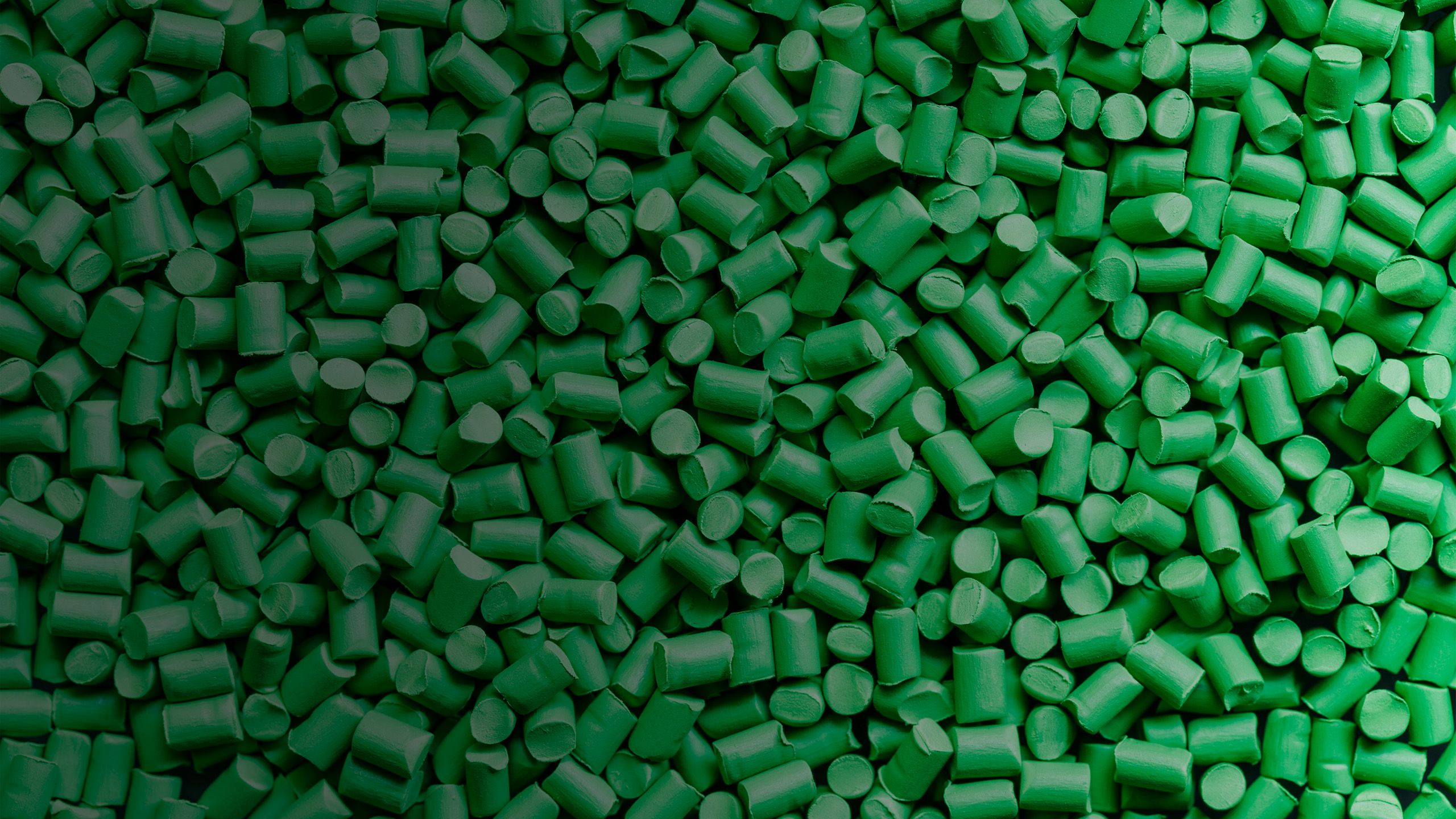
Each year, several million tonnes of waste plastics end up in the ocean, posing a serious threat to the ecosystem and human health. At Imperial College London, academic specialists in a range of disciplines are bringing their expertise to a new effort to address the problem. They are brought together by the multi-faculty Ocean Plastic Solutions Network.
Dr Arturo Castillo Castillo is a Research Fellow in the Centre for Environmental Policy and the network’s leader. He emphasises that there is no single solution to the problem of waste plastic. “The many functions of plastics and the many different products that contain them mean that we need to offer a plethora of solutions, not just one”, he says. “In place of a panacea, we advocate well informed interventions at every stage of the plastics value chain”.
Imperial is particularly effective, Dr Castillo Castillo adds, at understanding and influencing the trajectory of plastic before it reaches the ocean.
“We have very strong expertise in materials science, chemistry, product design and other parts that are upstream in the plastic value chain. This helps us work on interventions that prevent plastic from becoming waste. We also have strong expertise in chemistry, civil engineering and environmental policy that allows us to work on interventions to prevent the leakage of waste to the environment.”
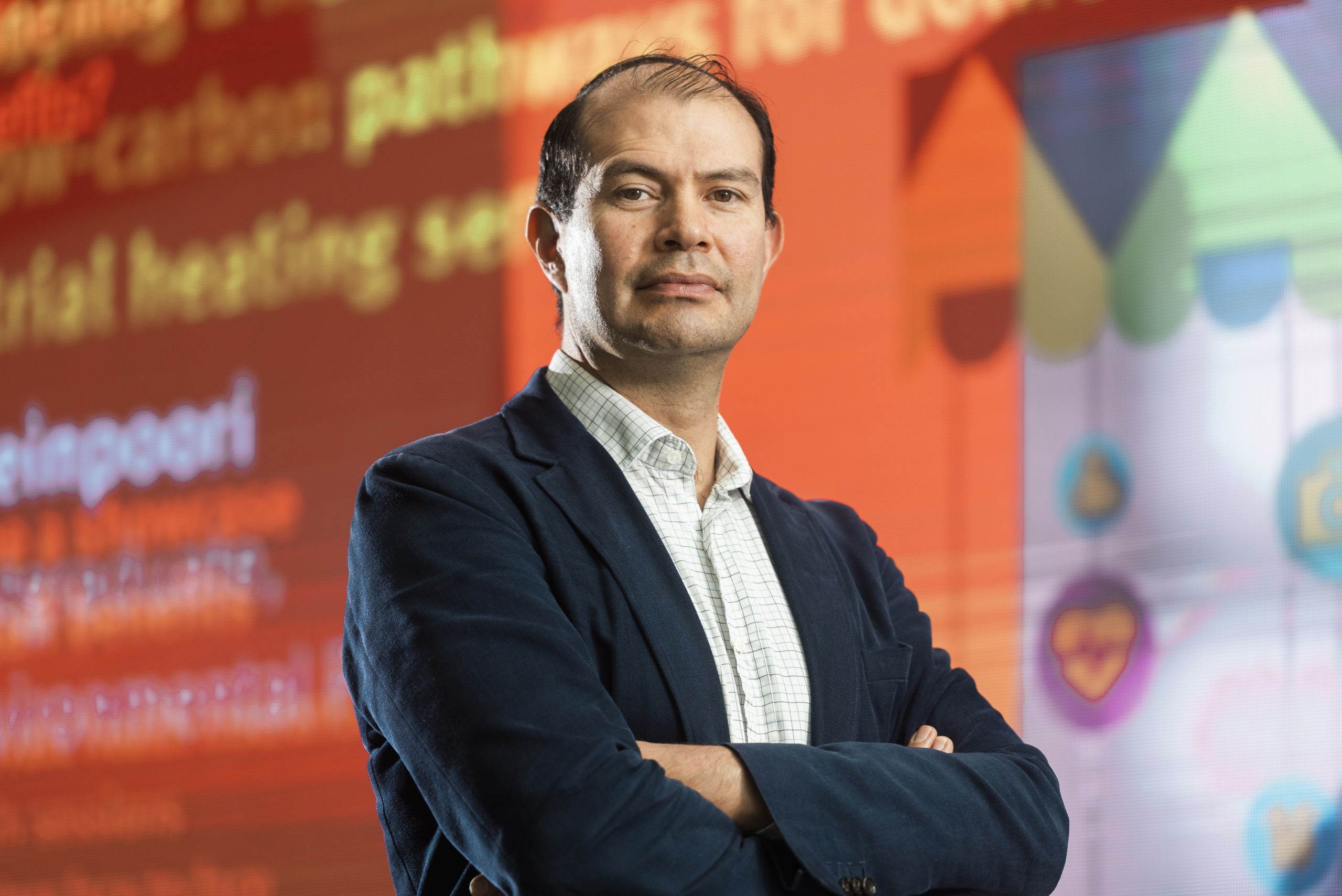
Dr Arturo Castillo Castillo, Research Fellow in the Centre for Environmental Policy and leader of the Ocean Plastic Solutions Network
Dr Arturo Castillo Castillo, Research Fellow in the Centre for Environmental Policy and leader of the Ocean Plastic Solutions Network
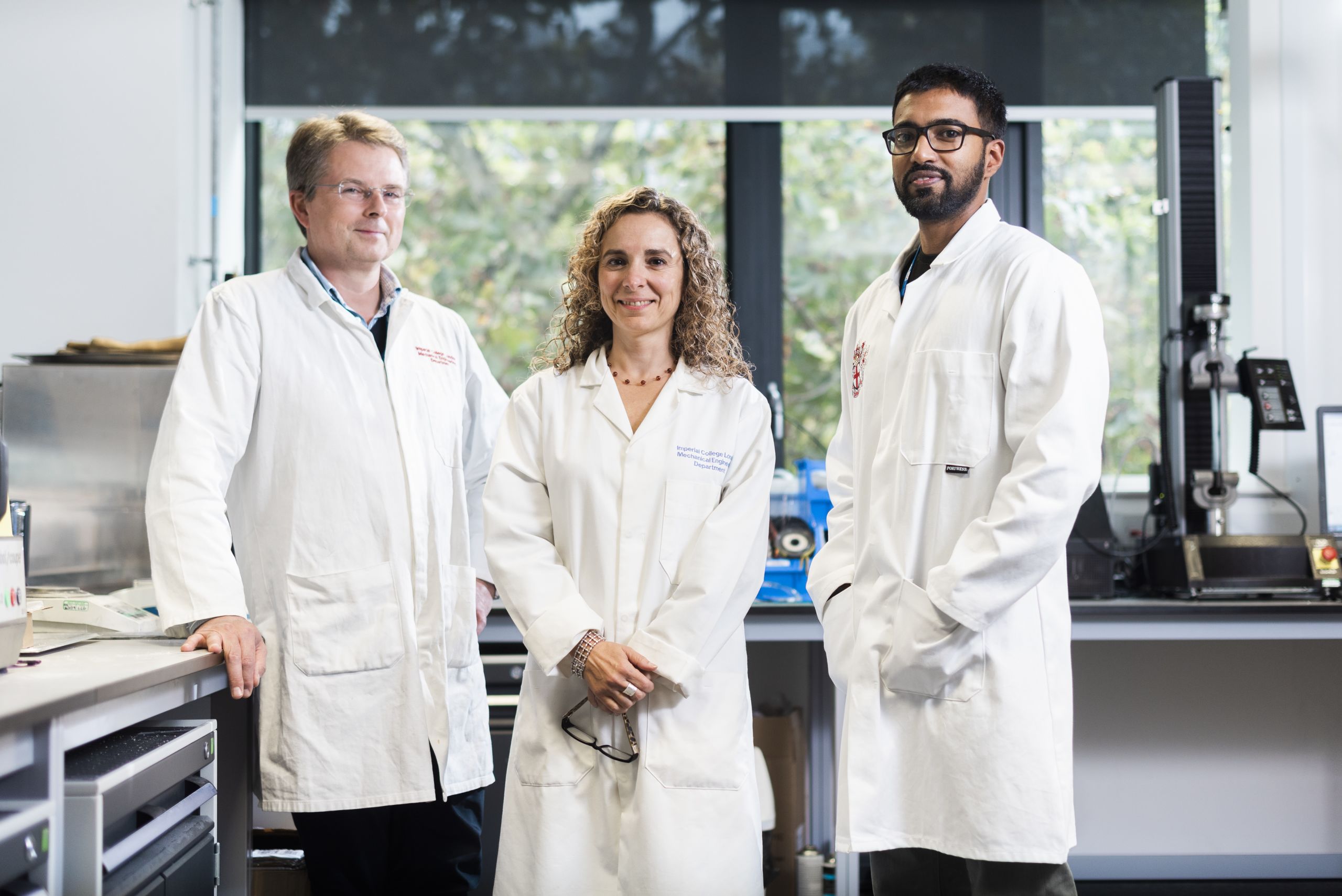
Dr Bamber Blackman, Professor Maria Charalambides and Dr Manu Mulakkal in the Department of Mechanical Engineering, who are working on innovative multilayer packaging.
Dr Bamber Blackman, Professor Maria Charalambides and Dr Manu Mulakkal in the Department of Mechanical Engineering, who are working on innovative multilayer packaging.
Easier-to-recycle packaging
A lot of plastic packaging is multilayer, consisting of films made from differing materials, adhered on top of one another. Crisp packets are a good example. Multilayer packaging usefully exploits the differing properties of the materials, with some that block light, others that block oxygen and others that add rigidity, for example. By preserving food effectively, the packaging helps avoid waste and therefore helps make food sustainable.
However, multilayer packaging is challenging when it comes to recycling because the layers can’t easily be separated. Recycling the packaging yields a composite material that typically lacks the useful properties of the original packaging and may not be suitable for packaging at all .
Professor Maria Charalambides, together with Drs Bamber Blackman, Soraia Pimenta, Ambrose Taylor and Daniel Balint, in Imperial’s Department of Mechanical Engineering, aim to address this problem. One solution they are pursuing is the use of compatibilisers – materials added during recycling that can be blended with original materials to yield a polymer blend that is useful and reusable.
“A better solution would be if you could separate the films”, says Professor Charalambides, who is co-lead of a new project: ‘Holistic integration of technology, design and policy for a greener plastic future’ (Greener Plastic Future), funded by the Engineering and Physical Sciences Research Council.
She is about to begin looking at ways of partially bonding separate films so that they can easily be separated afterwards during recycling. “This will be very much industry-driven. I’m hoping that new ideas will emerge from collaboration with our industrial partners – so we’re able to propose a holistic solution.”

Illustration: Multilayer packaging, which helps avoid food waste, but can be challenging to recycle.
Illustration: Multilayer packaging, which helps avoid food waste, but can be challenging to recycle.
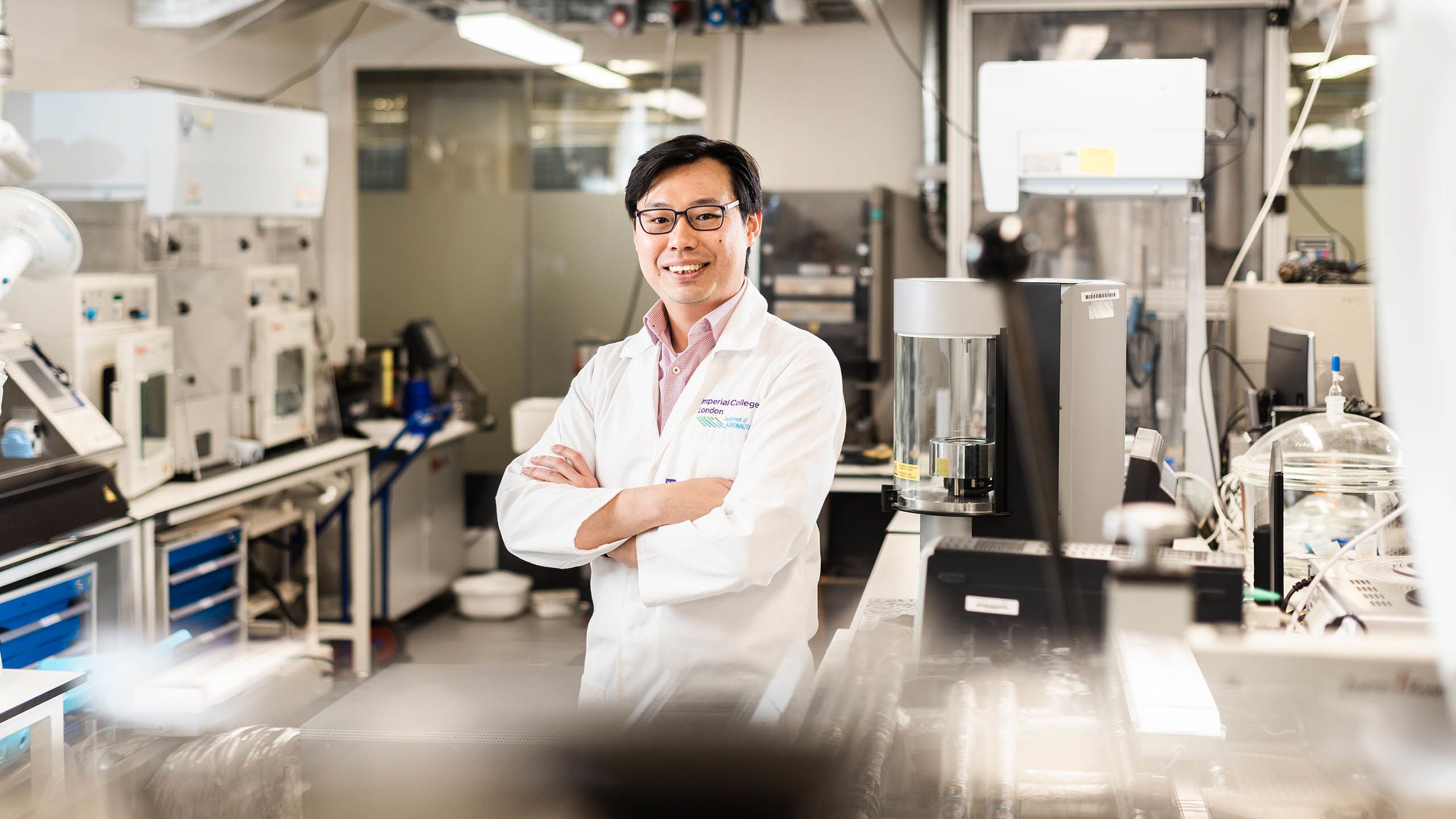
Dr Koon-Yang Lee, in the Department of Aeronautics
Dr Koon-Yang Lee, in the Department of Aeronautics
Waste-reducing polymers
Dr Koon-Yang Lee, a senior lecturer in the Department of Aeronautics, leads the department’s Future Materials Group, which develops and manufactures novel polymeric materials. Improving sustainability is one of their central aims.
One area of their research focuses on making polymer foams. “We have a manufacturing process similar to making meringue”, Dr Lee explains. “You beat air into very viscous epoxy resin, which creates a shaving foam-style cream that you can shape into any form you want and let it set. This includes unusual shapes, such as the shape of an aerofoil.” One advantage of the approach is a reduction of waste. “Usually, you machine a big block into the shape you want, and you have to throw away the residue – it creates waste. In our case you don’t have to machine it. You can shape it however you like.”
As part of Greener Plastic Future, Dr Lee is starting research on making better use of post-consumer waste. Usually this is downgraded, meaning that the new material is less valuable than the material it was recycled from. Dr Lee’s group is identifying ways to upgrade post-consumer mixed waste using additives and reinforcing fibres. “This gives us a chance to see plastic not as waste but as a valuable feed into higher value applications”, he says.
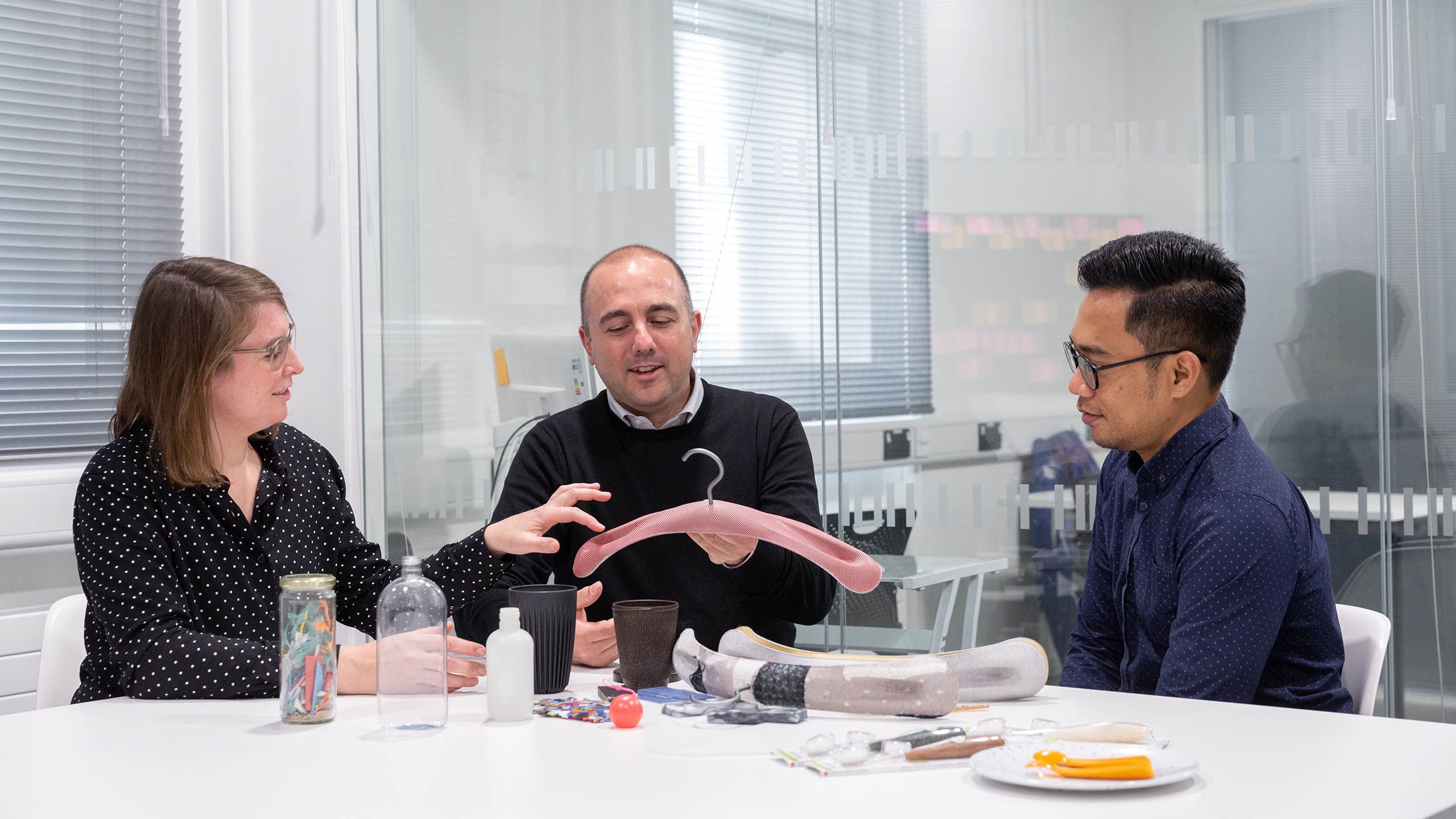
Anouk Zeeuw van der Laan, Dr Marco Aurisicchio and Fadzli Bin Bahrudin at the Dyson School of Design Engineering
Anouk Zeeuw van der Laan, Dr Marco Aurisicchio and Fadzli Bin Bahrudin
Circular systems
Dr Marco Aurisicchio, a senior lecturer in the Dyson School of Design Engineering, is co-leader of the Ocean Plastic Solutions Network and co-investigator on Greener Plastic Future.
He is also supervising industry-funded research that explores how designers can consider the entire lifecycle of products and configure the systems to produce closed loop material flows.
Characteristically for the School’s researchers, he does not consider product design in isolation, but looks at systems like manufacturing, consumption and end-of-life that materials and products are embedded within, and investigates how these influence material resource flows. “We think about humans, infrastructure and technology in the design of systems”, he explains.
Take, for example, the disposable camera. To develop your photos, you have to take the obsolete camera to a photo developing service. What you don’t realise is that by using this service you are allowing the company to re-use the camera’s components
Anouk Zeeuw van der Laan is a PhD student working with Dr Aurisicchio on a project funded by Procter & Gamble. In a previous role, Ms Zeeuw van der Laan worked as a packaging technologist for another fast-moving consumer goods (FMCG) multinational. This sector produces low cost, non-durable items you might buy in a supermarket, including food products and items like disposable razor blades. The problem with these goods, she says, is that there is often a mismatch between the short lifespan of the product and the very long lifespan of the materials, including plastics, used to make them.
The project initially set out to identify more sustainable materials. “The first conclusion that we drew was that we can change the materials we use, but if we don’t change the way we use them we will still have the same problem”, she says. “For example, biodegradable materials will only biodegrade if we send them to the right places. So, instead, my research focuses on the design of consumption systems that get materials to those places.” Ms Zeeuw van der Laan studies product–service systems – business models that combine products with services, and have potential to achieve more sustainable outcomes.
“Take, for example, the disposable camera”, she says. “The camera is designed to give you 27 pictures and then the whole product becomes obsolete; but it still has a significant value for the consumer. To develop your photos, you have to take the obsolete camera to a photo developing service. What you, as a consumer, don’t realise is that by using this service you are closing the loop, allowing the company to intercept and re-use the camera’s components. Your incentive to return the components for re-use is hidden in the consumption of that system.”
Dr Aurisicchio and Ms Zeeuw van der Laan are looking at the role of consumers in product–service systems that involve take-back schemes offered for FMCGs. “You might expect incentives like money and discounts would make a difference. But there can also be implicit incentives such as increased convenience. Moreover, we found that the roles of consumers imply costs, which could be minimised by eliminating or alleviating the activities that constitute the role.”
In forthcoming work, the researchers will develop a tool to help companies like Procter & Gamble model the flow of resources in a consumption system. “A common approach is to look at the circular economy from a business perspective – what changes for my business – or what changes for a consumer”, she says. “Instead, we take a resource-centric approach in which we put the flow of resources first. Resources are always a part of circular economy research. But to put them above value creation is, I think, a novel approach.”
Improving perceptions of sustainable goods
Fadzli Bin Bahrudin, another PhD student working with Dr Aurisicchio at the Dyson School of Design Engineering, is applying his experience as an industrial designer to understanding user perceptions of sustainable consumer goods.
While innovative products made from recycled and renewable materials – examples include trainers made from recycled ocean plastic and cups made from coffee grounds – are sometimes novel enough to grab the headlines, Mr Bin Bahrudin points out that they will only help achieve a widespread reduction in environmental impact if consumers are actually willing to adopt them. “The cloudy and grey appearance of a 100% recycled PET water bottle puts environmental consciousness to the test”, says Mr Bin Bahrudin.
“The company might consider the unconventional appearance a ‘badge of honour’, but users often find it aesthetically unpleasing.” Because the move to consumer goods manufactured from sustainable materials is relatively new, Mr Bin Bahrudin is among the first to conduct systematic research into consumer perceptions of the goods through detailed interviews with study participants.
“My findings show that users feel positive about the environmental impact of the materials, but uncertain about their quality. Even worse, learning the origin of some materials, for example agricultural by-products, can trigger the feeling that the product is somehow contaminated, and even feelings of disgust.”
Mr Bin Bahrudin is testing the hypothesis that designers can overcome this problem by making the life stories they tell about the materials an integral part of the design process. “I believe that information about the origin of the material can be presented to users in the form of a compelling narrative. For example, a coffee cup that is made of coffee waste from cafes around London is going to be perceived differently than a cup made of coffee waste from an unknown source”, he explains.
Understanding toxicity
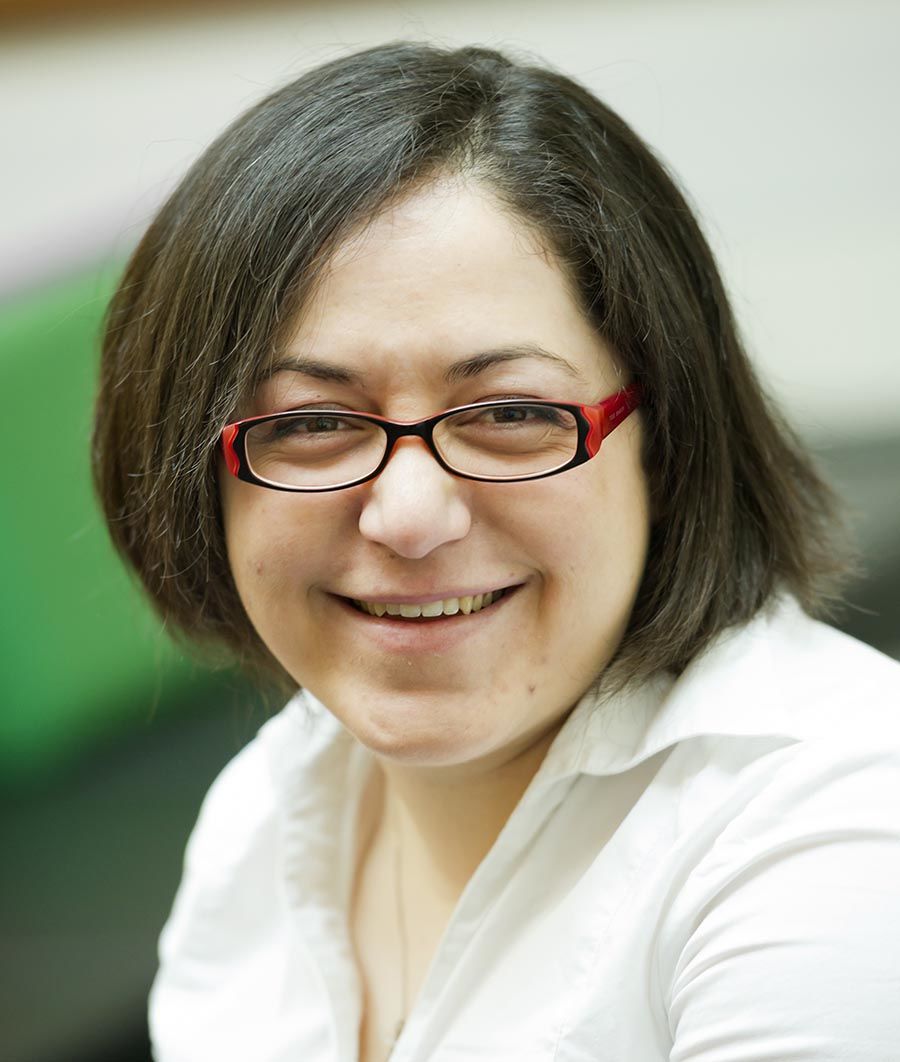
Dr Theoni Georgiou, senior lecturer in Imperial’s Department of Materials, has a long track record working with polymers – the repeating chains of molecules that when malleable are known as plastics. As the incoming chair of Macro Group, which represents polymer chemists across the UK, she hopes to improve public understanding. “I would like people to understand that not all plastics are bad. There are bad ones and good ones”, she says.
Dr Georgiou’s research has always been oriented toward practical solutions. One example is drug delivery systems. The drugs used to treat brain conditions including cancer must, due to the blood-brain barrier, be injected directly into the brain. As liquid will not stay in the brain long enough for the drug to have an effect, the drugs need to be delivered through solutions containing specially created polymers that condense into gels at body temperature.
But this technique is not perfect, because the polymers are quite viscous even at room temperature, making them hard to inject. Dr Georgiou used her expertise to develop a now patented polymer that causes the solution to turn into a gel at one third of the concentration of those currently used, making the solution much easier to use.
Dr Georgiou is now turning her polymer expertise to sustainability. Recently, there has been a great deal of public attention to the fact that degraded plastic waste frequently finds its way into human bodies. Less understood are the health implications of ingesting plastic. “Many plastics can pass through our bodies harmlessly”, Dr Georgiou explains. “Others are not toxic themselves, but as waste plastics can pick up toxins and carry these to the body. When manufacturers develop plastic products that aren’t for consumption, such as airplane windows, they don’t usually examine whether the materials are harmful to ingest.”
Dr Georgiou is working with Professor Alexandra Porter, also in the Department of Materials, to investigate how small particles of plastic, like those that occur when plastic waste degrades, interact with bacterial cells. If the plastic kills the cell, this may indicate that it is toxic. If the plastic absorbs the cell, this may indicate it can transport toxins from the ocean to human bodies. If they do not interact, this makes it more likely that plastic particles of this type or size are not harmful to humans.
“This is the start of a new effort to help industry and policy-makers better understand the health consequences of choosing one plastic over another”, Dr Georgiou explains.
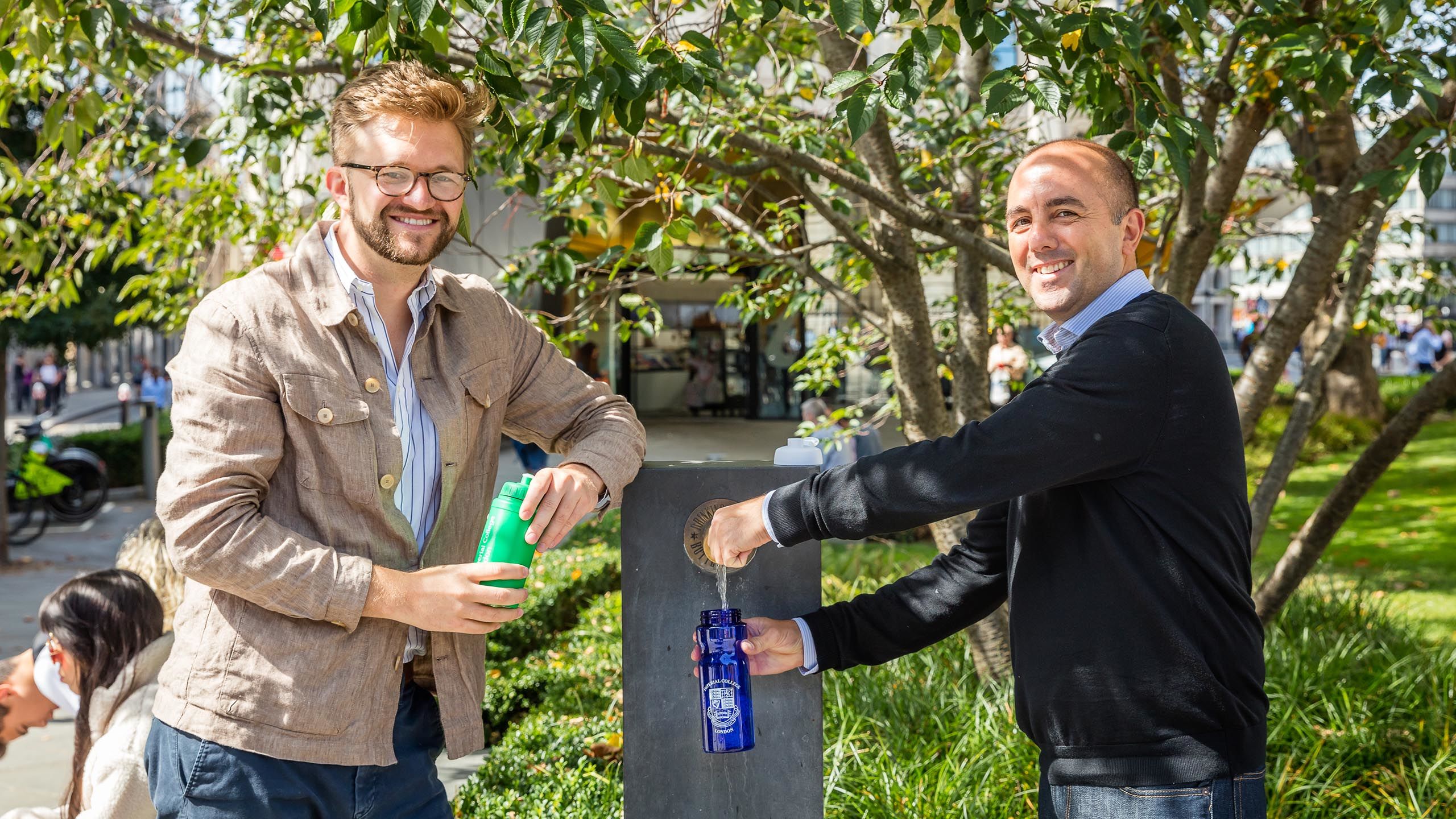
Dr Weston Baxter and Dr Marco Aurisicchio, who are advising the City of London Corporation on water refill stations as part of the Plastic Free City campaign.
Dr Weston Baxter and Dr Marco Aurisicchio, who are advising the City of London Corporation on water refill stations as part of the Plastic Free City campaign.
Eliminating single-use plastics
Dr Aurisicchio and Dr Weston Baxter, a lecturer in the Dyson School of Design Engineering, are lending their expertise to an ambitious initiative that aims to end the unnecessary use of single-use plastics in London’s financial district.
The City of London Corporation’s Plastic Free City campaign is encouraging companies, retail outlets and residents in the square mile to pledge to stop using plastic items like cups, straws and takeaway containers, which often end up in oceans and can take 450 years to degrade. To support the effort, the Corporation is installing an extensive network of water refill stations.
Dr Aurisicchio and Dr Baxter are experts on the impact that product design has on behaviour. They will evaluate when and to what extent the water fountains are being used by specific groups such as residents, tourists and workers by analysing data from a variety of sources including smart meters attached to the refill stations.
The work draws on Dr Baxter’s expertise in behaviour change and contaminated interaction, the changing attitudes people have to products and spaces that are shared. “Water and the fountains that deliver them are sometimes considered by consumers to be ‘contaminated’ or unhygienic, and we’re interested in design interventions that can overcome this barrier to uptake”, Dr Baxter explains. “Uptake is important because we also have to consider the environmental impact of manufacturing reusable bottles. They require much more energy to produce than single-use bottles so if they aren’t being used, they aren’t a worthwhile intervention.”
The work with the City of London will help Dr Baxter and Dr Aurisicchio make recommendations about how water fountains can most effectively be deployed in the City and other boroughs, and will help shape policy at a national level through briefings to the government.
Dr Baxter says: “It’s exciting to see businesses working so closely with local government as part of a group that really cares about an evidence-based way to get this right and make a real difference to how we make use of our resources in London. We are working to go beyond the political and media commentary which has painted all plastics as bad and bring more nuance to the discussion. I hope it can be a model for other neighbourhoods and cities.”
The right policy interventions
Dr Castillo Castillo’s own work in the Centre for Environmental Policy is at the interface with his colleagues’ scientific and engineering research into plastics across Imperial. In his work, he investigates policy interventions that most effectively incentivise positive changes such as reducing waste generation in the first place or improving recycling. “You can introduce guidelines, targets or mandates”, he explains, “but the question is what incentive, penalty and reward system you can use and in what time frame.”
“How do we build and position a policy proposal so it is taken up, and what is the right way of deploying existing policy tools, in terms of timing, testing, roll out, and monitoring?” There is also a question of unintended consequences. “We can provide deeper analysis into the effectiveness of different technical and policy interventions. For instance, we know that bans, such as a ban on plastic bags, can sometimes lead to illegal markets, equally polluting alternatives or other unintended consequences. Our aim is to provide the evidence base about not only environmental impacts but also societal and market effects, and potential unintended consequences, which will inform more sustainable policy decisions”, Dr Castillo Castillo says.
Dr David Silverman is Enterprise Communications Officer.
Infographic by Icographic. Photos by Thomas Angus, James Tye and Dan Weill.
This Imperial Story was produced by the College's Enterprise Division.
The Enterprise team helps businesses to solve their challenges by accessing Imperial's resources, talent and expertise, and helps academics and students find new ways to turn their expertise into benefits for society.
